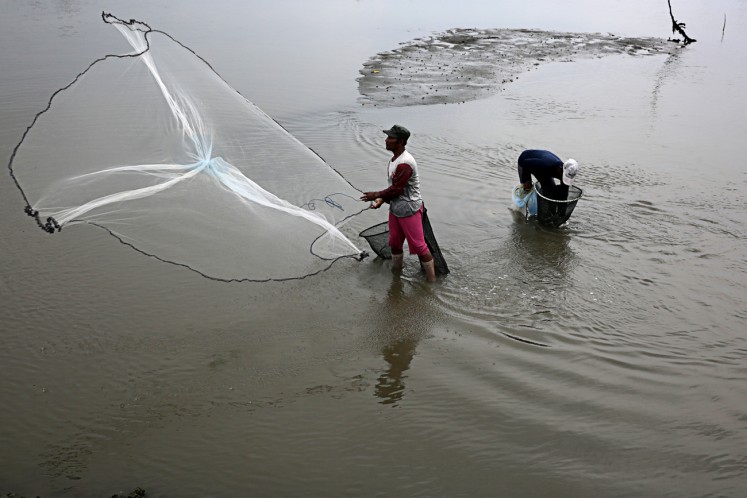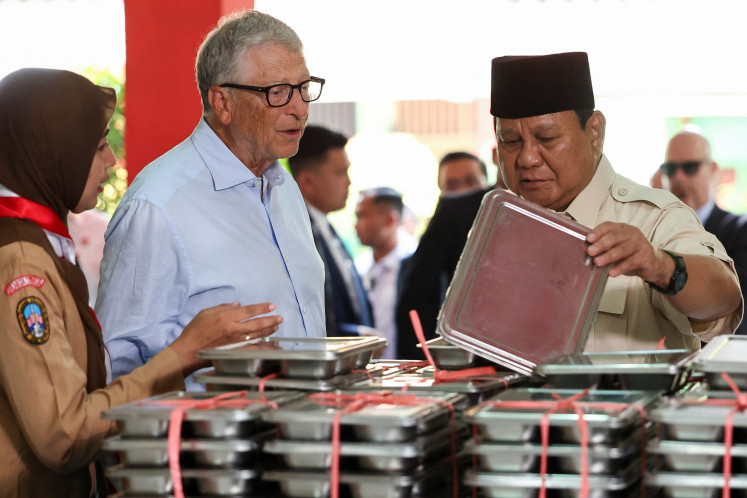Popular Reads
Top Results
Can't find what you're looking for?
View all search resultsPopular Reads
Top Results
Can't find what you're looking for?
View all search resultsA history of violence ensnares city students
Aside from traffic jams and floods, student brawls are on the top of a list of never-ending woes that everyday Jakartans have to endure
Change text size
Gift Premium Articles
to Anyone
A
side from traffic jams and floods, student brawls are on the top of a list of never-ending woes that everyday Jakartans have to endure. The Jakarta Post’s Hasyim Widhiarto investigates the root causes of the short fuse among high school students, who today consider fighting students from other schools part of an ingrained culture. Here are the reports:
Dozens of high school students, still in their white-and-grey uniform, walked slowly toward a group of students from other schools sitting on a sidewalk in front of Pusat Grosir Cililitan shopping mall in East Jakarta on Friday.
The approaching students provocatively shook their fists with the thumb and little finger open to identify the place they were studying — SMK Gutama vocational school for aviation engineering.
Fifty meters before the engagement, their rival students, who were apparently from SMK Bhakti vocational school in Cawang, East Jakarta, stood up and made hand gestures insulting to SMK Gutama students.
A brawl broke out, with rival students chasing each other around the busy Cililitan intersection. It was not until a traffic police officer stepped in and tried to detain one of them that the brawl ended.
“See, we didn’t even need a word to start a brawl,” Al, 16, a 10th-grader at SMK Bhakti, said. Student brawls have become routine, particularly every Thursday — a day he called “National Brawl Day” or “Thursday’s Mayhem”.
Brawls among students from different school have long been a tradition that has given those repeatedly involved in such violence a sense of pride.
Authorities have seemingly run out of ideas to put a permanent end to the practices, deeply rooted since the 1970s.
School fights have not only created a generation prone to settle problems using violence, but have also led to serious and permanent injuries, or even deaths. According to media reports, at least four students died in brawls last year, while this year one has been reported thus far.
“There’s never any clear reason why we start a brawl. Even simple physical gestures can be interpreted as a challenge to fight,” said Al, adding his seniors had groomed him and his friends to consider certain schools enemies for no logical reason.
When a fight takes place, Al will immediately take out a sharpened bicycle gear and swing it over his head on a rope, hoping its sharp edges will wound his opponents.
Aside from fighting students from SMK Gutama, Al said his school’s top rivals included students from Central Jakarta’s SMK Boedi Oetomo dubbed as one of the city’s most notorious schools for inciting brawls.
To anticipate unexpected attacks, the students have no option but to travel to and from school in groups.
Adam, 16, an 11th-grader at SMKN 56 State vocational school in Penjaringan, North Jakarta, travels by motorcycle in convoy with his schoolmates, as the safest way to reach home unharmed.
“Street attacks have become a regular thing for us,” Adam said. “Most of our enemies [from other schools] recognize us through our uniform. They even know those of us who are often involved in school fights.”
The threat of violence does not seem to bother Adam and Al. “Beating them in a fight is something to be proud of,” Adam said.
J.J. Rizal, a Jakarta historian from the University of Indonesia, believes the root causes of school fights can be traced back to the mid-1970s, after a few students from different schools successfully organized a series of attacks on rival schools they considered “annoying”.
“Like today, students at the time attacked each other for petty reasons, such as over spaces on public transportation and over taunts in the street,” Rizal said.
Students involved in the city’s early school brawls in the 1970s and 1980s usually attacked each other by throwing rocks. Decades later, the fighting methods have escalated to more dangerous levels, with students bringing knives, samurai swords, sickles and sabers to the fighting scene.
“Since the 1980s, many students have started to see school fights as a tradition. A school’s alumni and senior students play their part in institutionalizing school rivalry by passing on their ‘fighting experiences’ to their juniors,” Rizal said.
“It explains why some schools in the city, until today, have a very strong esprit de corps when facing school fights.”
Students have found new ways of keeping the aggressive culture thriving by promoting and encouraging brawls online.
As of last week, for example, almost 4,000 students and alumni had joined a Facebook group named “aku cinta TUBIR” (I love brawls), which provides online discussion on school rivalries and information on the latest brawls in the city.
Students in the group can post comments expressing their hatred of or support for certain schools.
Another website providing information on school brawls is www.tubirmania.co.cc, which allows students to send videos or photos of street brawls and contribute stories of their fighting experiences.
The site posted the profile of dozens of schools that have a “reputation” in the fighting arena, complete with their logos and pictures of their students. There are 370,000 high school students in Jakarta, studying in around 1,000 general and vocational schools.
While no official statistics are available to gauge the magnitude of the violence, the Jakarta branch of antinarcotics and anti-brawl organization Gepenta in 2008 indicated at least 137 schools as being regular troublemakers.
The Jakarta Police spokesman Sr. Comr. Boy Rafli Amar said Sunday the police had estimated only less than 10 percent of high schools and vocational schools have students engaged in school fights. The number is more or less similar every year, Boy added.
But the impact of student brawls are not confined to statistics.
Psychologist Diena Haryana from Sejiwa, a foundation which deals with overcoming bullying among students, said the impact could be devastating for a generation.
“Students having exposure to intense violence will eventually lose their values of mutual respect, empathy and tolerance toward differences,” she said.
“They will also respond to difficult situations aggressively.”
She said reasons for fighting could vary, from economic woes to lack of parental affection.
“The most important thing is that school and parents must work hand in hand to overcome this problem and not blame each other if students become embroiled in a fight,” she said.










